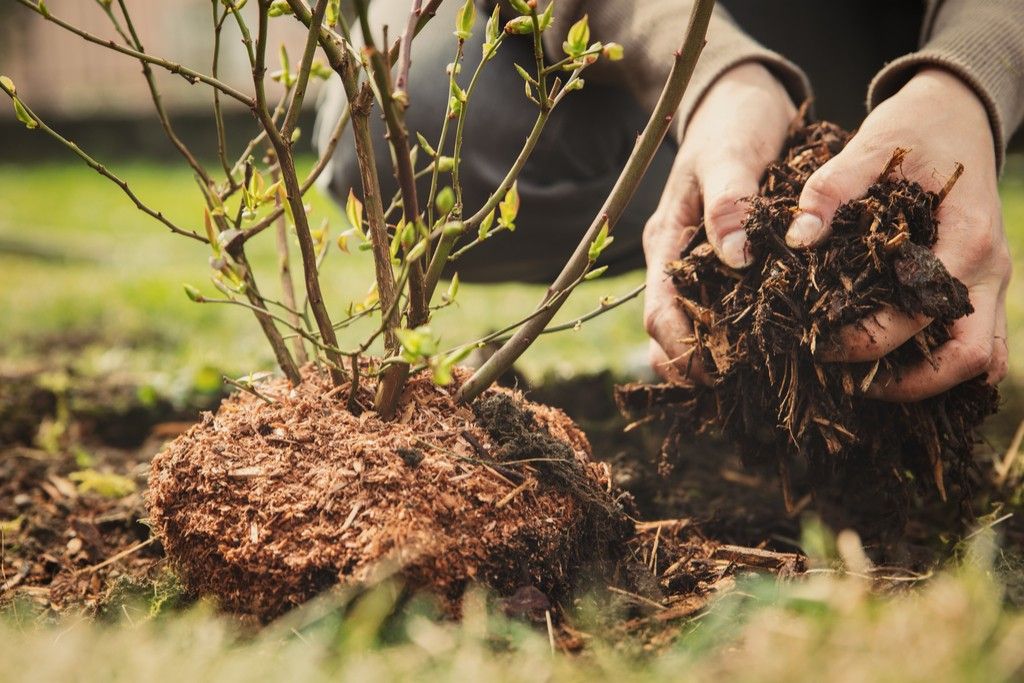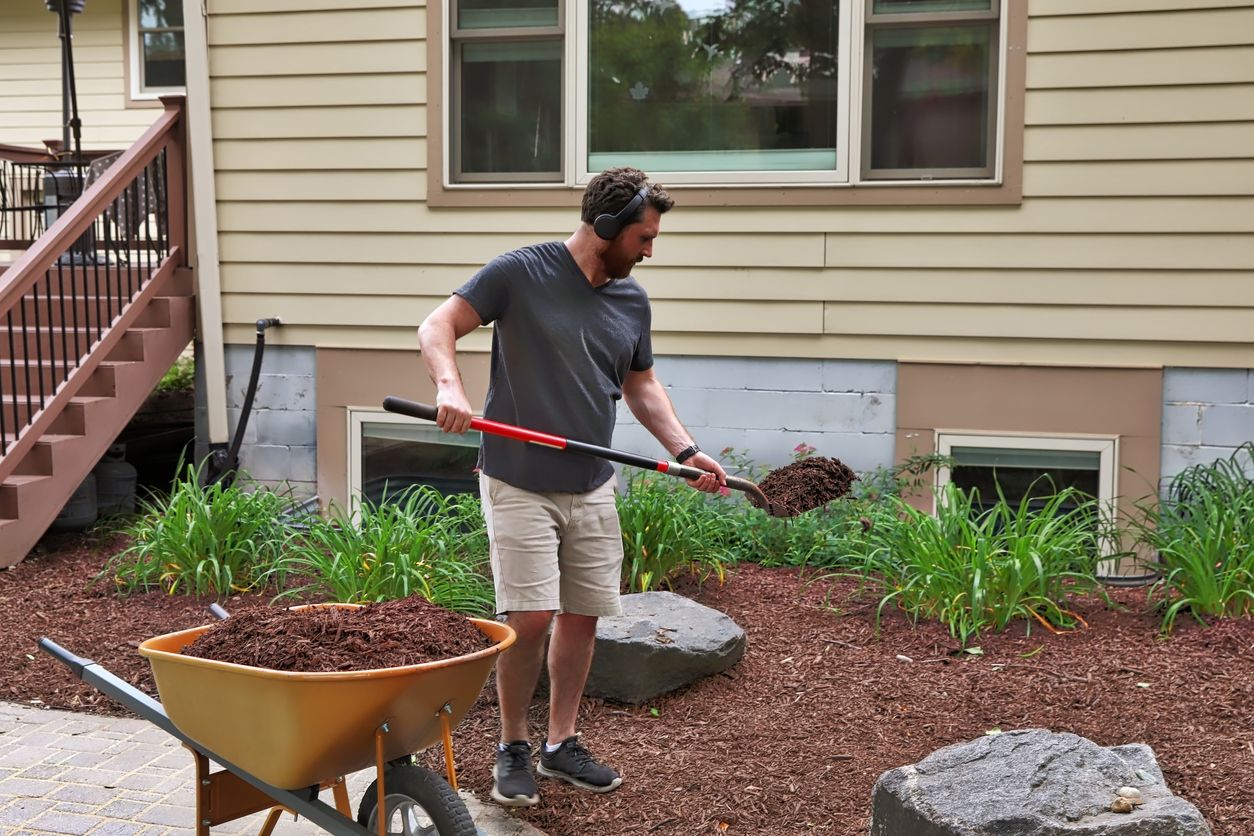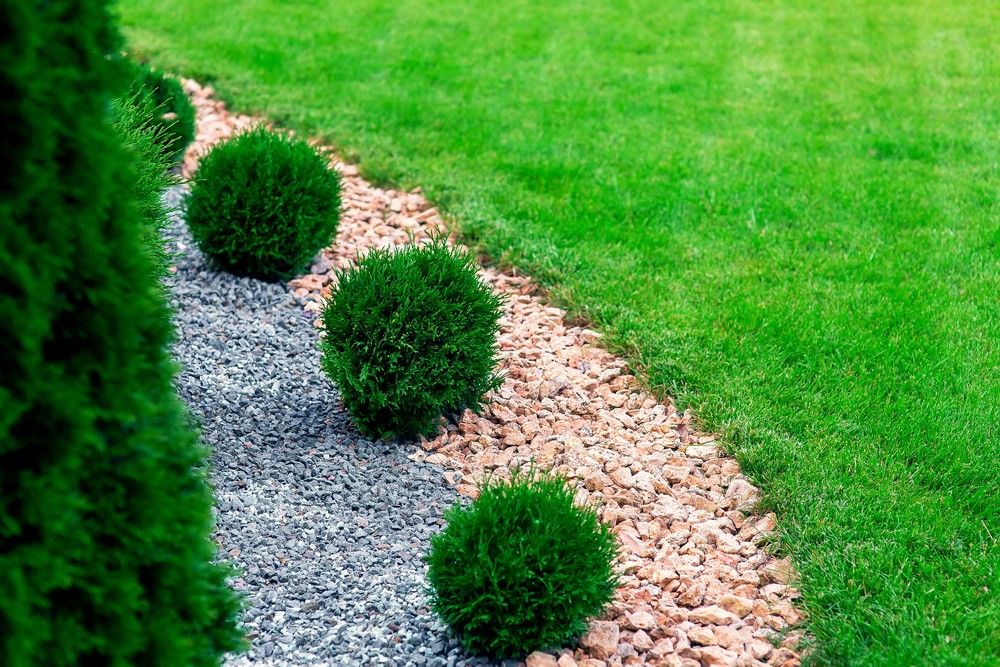What Is Mulch, and How Can It Transform Your Garden Into a Paradise?

No matter how big your yard is, your landscaping can have a major aesthetic impact. And beyond the flowers, plants, shrubs, and trees you choose to plant, other elements come into play—including mulch. The widely used item may look like simple wood chips, but it’s actually a practical part of managing your lawn, suppressing weeds, and protecting soil and plant roots. But what exactly is mulch, and what’s the best way to use it to help your garden flourish? Read on for all the expert information on one of the most underrated lawn materials.
RELATED: 5 Plants That Will Keep Mosquitoes Out of Your Yard, According to Pest Experts.
What Is Mulch?

Anyone who has set foot in a yard, garden, or park has seen some type of mulch being used as part of the landscaping design. But experts say that the term actually applies to more than just wood chips.
“Quite simply, mulch is a layer of material that’s spread over the surface of the soil,” says Darren Muzzy, director of operations at Michigan Tree Experts. “Various organic and inorganic materials can be combined to create it.”
What is mulch made out of?
You might assume that mulch is always made of wood shavings or chips, thanks to the types often sold at home and garden stores. However, different types are available for you to choose from, depending on what you hope to achieve.
“There are technically two types: organic mulch and inorganic mulch,” says Janet Loughrey of Garden Design. “Organic mulches can include compost, manure, shredded bark, wood chips, grass clippings, pine needles, straw, grass, or leaves. Inorganic mulches include gravel, stone, plastic sheeting, or landscape fabric.”
What does mulch do?
Anyone who’s used mulch for garden or lawn purposes knows it can be an easy way to make things look more orderly and manicured. But novice gardeners who don’t know what mulch is used for may be surprised to learn it’s also performing a few vital functions that can help keep your yard healthy.
“Mulch can help the soil retain water better, suppress weed growth, keep the plant roots cool in the summer, and help prevent them from frost damage in the winter,” explains Petar Ivanov, gardening and plant expert with Fantastic Gardeners.
According to Jane Dobbs, gardening team lead at Allan’s Gardeners, gardeners of all levels need mulch to keep their gardens healthy.
“It has tons of benefits for your ecosystem,” she tells Best Life. “Mulch keeps weed seeds at bay and blocks sunlight, reducing weed growth and the need to weed manually. A mulch layer also helps conserve moisture, preventing water evaporation from the soil and keeping plant roots hydrated.”
She adds that, over time, organic mulch enriches the soil with essential nutrients, encouraging microbial activity and growing healthy plants. “Additionally, it can reduce surface runoff and protect bare soil from heavy rains and winds.”
RELATED: Gardening Influencer Reveals the #1 Plant to Give Your Yard Beautiful Color.
Can I make my own mulch?
Packaged mulch is widely available for purchase at most home and garden stores. But if you’re going to use a lot of it, Dobbs says it might be beneficial to go a little DIY and make your own mulch.
“Collect grass clippings after mowing your lawn and spread them around your garden beds as mulch,” she suggests. “You can also shred fallen leaves into a mulch for your garden in the fall to add nutrients—especially with deciduous leaves like maple, oak, and birch since they decompose slowly, adding organic matter over time.”
She adds that you can also compost vegetable peelings, fruit rinds, and coffee grounds and use them in your yard as mulch once they’re broken down into rich and dark compost. The best part? This turns kitchen waste into free fertilizer and nutrients for your yard.
With the right equipment or services, you can also create plenty of materials from your own backyard.
“If you have a chipper, you can make your own mulch with tree trimmings,” says Blake Watkins, certified master arborist and operations partner at Monster Tree Service.
How else can I save money on mulch?
Gardening beginners might assume mulch is just another item that will go towards running up a serious bill.
“Many local tree care contractors will give away arborist wood chips for free,” Allen Tate, an arborist and tree care operations manager at Blooma Tree Experts. “This is basically all the chipped-up trees and branches they generated from doing tree work in your area.”
“Some companies will even give you a discount on your tree work if they can leave the chips on site,” Watkins explains.
Tate adds that, for the most part, the resulting biodiversity from arborist wood chips is actually better for your soil than the colored or single-source type of mulch you may buy at a garden store.
RELATED: 5 Invasive Trees You Need to Remove From Your Yard Immediately.
How/Where Should I Apply Mulch To My Garden?

The weather where you live will obviously have an impact on your gardening schedule. However, experts say that there are a few essential tips to keep in mind when planning your timeline.
“Generally, the ideal time for mulch application is in the spring when the weather has warmed up and stays consistently that way,” says Ivanov. “It’s also important not to apply it too early because you may bury perennial plants that haven’t yet emerged.”
But if you run out of time, you’re not totally out of luck. “Alternatively, you can also apply mulch in autumn to help the soil retain moisture better during the winter months and protect plant roots from the cold temperatures,” he says.
Dobbs points out it’s essential to clear the area of weeds, debris, and old mulch before applying a new one or putting down any plastic sheeting you may be using. You should also use a rake or garden fork to loosen the soil and potentially soak it with water before spreading.
How much mulch should I use?
As with most things garden-related, moderation is key here also. This rule still applies when trying to figure out how much mulch to lay down in your fresh layer.
“Mulch can be used in garden beds, pathways, or along slopes,” says Loughrey. “For coarse organic materials such as wood chips or straw, apply mulch in an even layer up to four inches thick. For finer organic materials such as compost, two inches is sufficient, while gravel or stone can be applied one to two inches thick.”
But again, it’s important not to overdo it. “Don’t mulch too deeply,” Dobbs warns. “While mulch provides excellent weed suppression and moisture retention, too much mulch can suffocate roots.”
Dobbs suggests to mulch evenly around the base of plants in garden beds, leaving a few inches between the stems to prevent moisture-related issues. “Also, mulch between vegetable rows to prevent weeds, conserve water, and keep the soil warm,” she says.
Are there any mistakes to avoid?
It’s not just about applying too thick of a layer to your garden bed: Tate also warns it’s important to avoid volcano mulching.
“This [term] refers to when people mound a heap of wood chips all the way up against the tree trunk, which looks a bit like a volcano,” he explains. “You don’t want moisture against the actual bark of the tree trunk, which can lead to fungal diseases or attract pests. You want the moisture above the root zone, which is where the tree will actually absorb the water.”
Are there any other places where I can use mulch?
Of course, not just garden beds can use layers. Mulch can also benefit other parts of your garden.
“You can cover paths and walkways with mulch, providing a natural and low-maintenance surface that suppresses weeds,” says Dobbs. “It can also be applied to potted plants to help keep them moist. Just spread mulch thinly over the soil surface, not covering the plant’s base or foliage.”
RELATED: 8 Easy Outdoor Plants That Don’t Need Sunlight.
Should I Use Plastic Sheeting?

According to Dobbs, whether to use plastic sheeting along with your mulch depends on various things, like your gardening goals, the type of plants you’re growing, and the weather.
“By blocking sunlight, plastic sheeting blocks weed growth and helps prevent weed seeds from germinating,” she says. “Basically, it reduces the need for manual weeding and herbicides, saving time and effort.”
However, she warns that the biggest problem with plastic sheeting is its impermeability. “It restricts air and water exchange between soil and atmosphere. If you have heavy clay soils, you might end up dealing with soil compaction, poor drainage, and root suffocation,” she cautions. “And while plastic sheeting can help warm the soil in cooler climates, it can also cause excessive heat buildup in warmer climates, causing soil overheating and plant stress.”
4 Types of Mulch You’ll Want to Use

Organic Mulch
Using plant-based or decomposable materials for mulch is popular for a reason. Besides being aesthetically pleasing, it also comes with plenty of long-term perks.
“Organic mulches are made of natural materials, and their main benefit is that they add extra nutrients to the soil,” says Ivanov. “I’d recommend organic mulch, specifically one made from wood chips or shreds, as the best and most beneficial because it decomposes naturally and adds extra nutrients to the soil. This type of mulch can also be used decoratively if aesthetics is what you’re looking for.” The other types he recommends for gardens specifically include compost and manure.
But it doesn’t have to be just repurposed plants or animal waste. “Newspaper or cardboard shredded as mulch works great for smothering weeds and keeping the soil moist,” Dobbs says. “But don’t use glossy or colored paper because it may contain chemicals that leach into the ground.”
Just keep in mind that there is one drawback to laying it down in your yard. “Because organic mulch is made of organic materials, it naturally decomposes and needs regular replacement,” Ivanov warns. “But when it decomposes, the decomposed material enriches the soil beneath it and improves its structure and drainage. And remember that the drier the material is, the slower it’ll take to decompose, and it’ll release fewer nutrients into the soil.”
Inorganic Mulch
Unlike plant-based options, inorganic mulches are made out of synthetic materials, make the soil more water-retentive, and suppress weeds. “And because [inorganic mulch is] synthetic, it also typically lasts longer than organic mulch—but it doesn’t add any extra nutrients to the soil,” Ivanov says.
There are also more inventive and interesting options available. “You can shred old rubber tires or mats and use them as mulch in areas where you want to keep moisture in,” says Dobbs. “It’s durable and long-lasting, and it keeps roots warm.”
She also suggests using broken pieces of terra cotta pots around your garden beds as mulch, adding rustic charm to your landscape while improving soil drainage. “And you can mulch with decorative stones or gravel where low maintenance and water conservation are priorities. It’s an excellent trick that looks stylish and suppresses weeds,” Dobbs explains.
Pine Needles
While wood chips may be the part of the tree that most often gets associated with munching, they are far from the only thing that can be beneficial.
“As pine needles are naturally acidic, they’re perfect for plants that love acid, like azaleas, rhododendrons, and blueberries,” says Dobbs. “When pine needles decompose, acid is released into the soil, helping plants maintain pH levels.”
She adds that the slow decomposition of pine needles provides long-lasting weed suppression and helps to conserve moisture, unlike some other organic mulches. “You won’t have to replenish it as often,” she says.
Grass Clippings
Dealing with the remnants of mowing the lawn is often a chore in and of itself. But experts say when appropriately used, it can go right back into your yard for some significant benefits.
“Grass clippings make excellent mulch,” Dobbs tells Best Life. “Just be sure to use them correctly to avoid matting and nitrogen depletion.”
She suggests laying out a thin layer of dried grass clippings over prepared soil. “Make sure they’re free of herbicides and pesticides, and don’t use clippings from a chemically treated lawn,” Dobbs says.
Conclusion

What mulch can do in your yard? After reading this article, you know how versatile this lawn and garden care item really is. Whether it’s made from organic materials such as wood chips or inorganic materials like stones, it can help suppress weeds, conserve moisture, and protect soil and plant roots. Just make sure you don’t use too much and prepare your yard before spreading down layers.